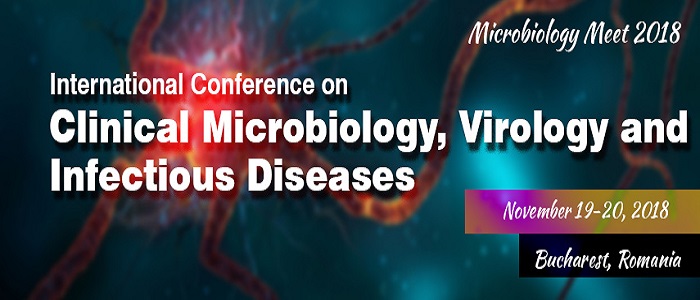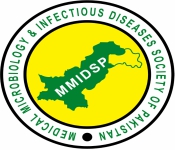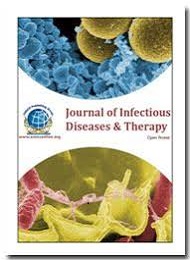Theme: Novel Advancements and Therapeutic Acuities in Clinical Microbiology & Infectious Diseases
Microbiology Meet 2018
With great pleasure we welcome all the participants across the World to Attend “International Conference on Clinical Microbiology, Virology and Infectious Diseases ” during November 19-20, 2018 in Bucharest, Romania. This conference is held based on the theme “Novel Advancements and Therapeutic Acuities in Clinical Microbiology & Infectious Diseases”. This conference provides a firm platform for scientists, engineers, directors of various companies, industrial professionals and students in the field of microbiology, virology, infectious diseases and other related fields to share their knowledge. We also take immense pleasure in welcoming various professionals from different countries all over the globe.
This Conference Microbiology Meet 2018 Focuses on Different Therapeutic Acuities in Clinical Microbiology & Infectious Diseases. It’s Also Provides a Great Platform for Doctors, Physicians, Research Scholars, Students, Industrialists and Pharmaceutical Professionals to Interpret Their Research Works on Infectious Diseases and Therapy Field. It Is Also a Great Opportunity to Intermingle with Members Across the World and Form Microbiology Community, Related Associations and Societies.
Our organization takes immense pleasure in welcoming,
o Directors, Board Members, Presidents, Vice Presidents
o Deans and Head of the Departments
o Business Entrepreneurs and Industrialists
o Microbiologist
o Virologists
o Parasitologist
o Bacteriologist
o Pharmacists
o Epidemiologists
o Dermatologists
o Neurologist
o Ophthalmologist
o Cardiologist
o Infectious Diseases Researchers, Scientists, Faculties, Students
o Infectious Diseases Associations and Societies
o Medical Colleges, Hospitals & Labs
o Pharmaceutical Companies and Industries
o Medical Devices Manufacturing Companies
o Drug Manufacturing Companies and Industries
o Laboratory Technicians and Diagnostic Companies
TRACK 1: Clinical and Molecular Microbiology
Clinical microbiology and molecular microbiology is the branch of microbiology which deals with the study of molecular basis and any microbes which causes infections. Because the concentration is on human disease, this focus is often studied by the basis of the specimen from the body – location, type of fluid or specific body tissue. Clinical microbiologists must be able to tell the transformation between normal microorganisms expected in a specimen and those causing an infectious disease. Because new-fangled microorganisms are being revealed all the time and they are developed more and more resisting the antibiotics. Henceforth they are cultured on an artificial medium in the laboratory and thereby it is found whether it is bacteria or fungi or virus or parasite during the time of illness
TRACK 2: Microbial Physiology and Genomics
Microbial physiology is the progression of understanding the cell assembly, growth factor, metabolism and the genomic composition of microorganisms. This interrelates the disciplines of microbiology, biochemistry and inheritances of a bacterial cell. Here genomics also plays a vital role where microbial physiology and genomics are inter-related. The study of microbial physiology and genomics are based on molecular biology concerned with the structure and function and evolution of a cell, the term genomics also defines the same, added it illustrates the mapping of genomes. To be more specific a genome is an organism’s complete set of DNAs which includes all genes.
TRACK 3: Pediatric Infectious Diseases
Pediatrics is a branch of medicine which comprises the medical care of infants, children’s and adults. Pediatric infectious diseases are diseases which is caused due to microorganisms and other microbes which involves bacteria, fungi, viruses and other pathogens. These kinds of pathogens infect the children’s and make them ill causing several harms. These infections may lead to Diarrhea and vomiting in babies. When the infections get Sevier, it disturbs the sleeping pattern of babies projecting them with pain of difficulties. Respiratory Syncytial Virus (RVS) and Sepsis is very common and contagious form of infections in babies.
TRACK4: Human Virology and Infectious Diseases
Infectious diseases befall when organisms such as bacteria, viruses, parasites or fungi come into our bodies and make us sick. These sicknesses can be passed from person to person. Hepatitis is a medical condition defined by the tenderness of the liver and characterized by the presence of inflammatory cells in the tissue of the organ. Hepatitis A is an intense irresistible infection of the liver instigated by the hepatitis A virus. Hepatitis B is an infectious disease instigated by the hepatitis B virus (HBV) which affects the liver. It can cause both intense and chronic infections. HCV is spread mostly by blood-to-blood contact linked with intravenous drug. The IHV focusses in the treatment of HIV/AIDS and other chronic viral diseases, such as Hepatitis C, Hepatitis B, and the Human Papilloma Virus Infection.
TRACK5: Vector Borne and Zoonotic Infectious Diseases
Vector borne and zoonotic diseases (VBZD) are infectious diseases that spreads through animal hosts or vectors. Vector borne diseases, such as malaria, are those in which an organism, insects, ticks, or mites, transmit a pathogen from one host to another, commonly with increased destructiveness (virulence) of the pathogen in the vector. Zoonoses, such as Avian Flu, are diseases that can be spread from animals to humans by either contact with the animals or through vectors that transmit zoonotic pathogens from animals to humans. While many vectors borne diseases, such as malaria, yellow fever, dengue, and murine typhus, are rarely seen, we are directly prone to Vector borne diseases that originate in warmer climates and susceptible due to comprehensive trade and travel. Many vectors borne diseases are climate sensitive and environmental changes associated with climate change are predictable to impact the spreading and occurrences of these diseases.
TRACK6: Food and Water Borne Infectious Diseases
Nutritious food is a necessity of life, and failure to obtain sufficient calories, macronutrients (fats, proteins, carbohydrates), and micronutrients (vitamins, minerals) can result in illness and death. Food can also be a source of foodborne illnesses, resulting from eating spoiled food or food contaminated with microbes, chemical residues or toxic substances. The possible effects of climate variation on foodborne illness, nutrition, and safety are habitually indirect, but on a universal scale, it can result in huge amount of population gets affected. Waterborne diseases are caused by a variety of microorganisms, biotoxins, and toxic impurities, which lead to distressing illnesses such as cholera, schistosomiasis and further gastrointestinal infections. Occurrences of waterborne diseases frequently leads to severe precipitation event (rainfall, snowfall). Because climate change increases the cruelty and frequency of some major sleet from waterborne diseases. In addition, diseases caused by Vibrio bacteria such as cholera and other intestinal diseases may pose a greater threat because that rising sea temperatures will have on the growth and spread of bacteria.
TRACK7: Airborne and Contact Infectious Diseases
Airborne diseases are instigated by pathogenic microbes slightly adequate to be liquidated from an unhealthy person through coughing, sneezing, laughing and handy personal interaction or aerosolization of the microbe. The discharged microbes remain deferred in the air on dust particles, respiratory and water droplets. Infection is caused when the microbe is inhaled or contacts mucus membranes or when discharges remain on a surface are touched. Contact Diseases are spread when a diseased person has direct physical contact with an uninfected person and the microbe is passed from one to the other. Contact diseases can also be spread by indirect contact with an infected person’s atmosphere or private items.
TRACK8: Health Care - Infectious Diseases
Variations in lifestyle have also led to the development of new threats to public health from infection. Health authorities depend on both medical consultants and research laboratory for information on the occurrence of these circumstances. An infectious disease professional is a professional of internal medicine is skilled on studying and treating infectious diseases. ID experts have knowledge in contaminations of the sinuses, heart, brain, lungs, urinary tract, bowel, bones and pelvic organs. Their wide physical activity focuses on all kinds of infections, including those instigated by bacteria, viruses, fungi and parasites. Infectious disease specialists also have extra training in how the body fights infection, how infections spread, and infection control.
TRACK9: Viral Oncology
Virology deals with the study of viruses their shape and structure and their daily habitual. Viral Oncology or Cancer Virology deals with the study of cancer cells. A virus named Oncolytic virus tends to infect and kill the cancer cells. These types of viruses tend to destroy the cancer cells or tumor cells through Oncolysis process where they release a new virus cells or virions which helps in the destruction of the remaining tumor cells and there by stimulate anti-tumor immune response. Cancer or Tumor virus infections are caused by Oncogenic DNA or RNA viruses.
TRACK10: Bacterial and Viral Vaccines
Immunization(vaccination) can be discrete as active immunity formed by vaccine. It is resistance and immunologic retention corresponding to natural infection but deprived of risk of sickness. There are two rudimentary categories of vaccines: live attenuated and inactivated. Live attenuated vaccines are produced by altering a disease-producing virus or bacterium in a research laboratory. Vaccines derived from bacterium is called as bacterial vaccine and from virus is as viral vaccine. The subsequent vaccine organism retains the ability to duplicate and produce immunity, but generally does not cause illness. Inactivated vaccines can be self-possessed either by whole viruses or bacteria, or portions of either.
TRACK11: Antimicrobials/Antibiotics/Antibacterial
Antimicrobials/ antibiotics/ antibacterial are the medications used in the treatment and prevention of bacterial infections. They may either kill or constrain the growth of bacteria. Rare antibiotics possess antiprotozoal action. Antibiotics are not active against viruses such as the common cold or influenza and their inappropriate use allows the rise of resistant organisms. These are a group of drugs that are used to treat infections caused by microorganisms/microbes/germs. A parasite is a type of microbe that needs to live on or in alternative living being (host). Antibiotics can be taken by mouth as liquids, tablets, capsules and they can be given by injection. An antimicrobial is semisynthetic or synthetic which kills or constrains the development of microorganisms but causes little or no injuries to the host. Wholly antibiotics are antimicrobials, nevertheless antimicrobials are antibiotics.
TRACK 12: Epidemiology - Infectious Diseases and Viral outbreaks
An Epidemic is a rapid spread of infectious diseases to a huge amount of people. The examination of molecular and cellular viscera establishing the immune system, incorporating their function and interface, is the key science of immunology. Autoimmune diseases are an extensive range of similar diseases in which the immune system produces an inaccurate retroaction against privy cells, tissues or organs, resulting in inflammation in addition wit damage. Cell-based immunotherapies are authorized to be a competent for some malignancies. Immune effector cells for instance, Macrophages, Lymphocytes, Natural Killer cells (NK Cell), Dendritic cells, Cytotoxic T Lymphocytes (CTL) etc.,
TRACK 13: Rare, Neglected & Tropical Infectious diseases
Neglected tropical sicknesses (NTDs) are a miscellaneous collection of tropical contaminations which are particularly common in low-income inhabitants in emerging regions of Africa, Asia, and America. They are instigated by a variety of pathogens such as viruses, bacteria, protozoa and helminths. These diseases are distinguished with big three diseases (HIV/AIDS, tuberculosis, and malaria), which usually receive better treatment and investigation funding. In sub-Saharan Africa, the consequence of these diseases as a group is like malaria and tuberculosis. Neglected tropical sicknesses co-infection can also make HIV/AIDS and tuberculosis deadlier.
TRACK 14: Emerging Infectious Diseases
More than ever before we are facing the threat of new diseases that apparently erupt out of nowhere. More than 70% of all new developing infectious diseases derive from animal host man-made wide spreading diseases have all arisen therefore from the annihilation of the rainforests, loss of wildlife habitats, and climate variation. Evolving infectious disease causes scruple rates upwards of 20 million people every year. Developing dimensions to reinforce and educate teams of researchers to help detect, prevent and control infectious diseases in animals and people Focusing on the early identification of dangerous wildlife pathogens and speedy response to prevent the spread of disease beforehand they become an important threat to public health. Early discovery of new viruses eventually helps the global public health agencies like the World Health Organizations and education to stop diseases in their tracks.
TRACK 15: Infection and Immune System
The immune system is classified into two categories, innate immunity and adaptive (acquired) immunity. There are major differences between the two divisions, but they share some cell functions and components. All living things are subject to attack from disease-causing agents. This kind of protection gets more sophisticated as organisms become more complex. Multicellular animals have devoted cells or tissues to deal with infection. Other rejoinders are slower but are more adapted to the infecting agent. Jointly, these protections are known as the immune system. The main portions of the immune system are: the natural barriers (skin, mucous membranes, etc.), nonspecific cells (phagocytes, natural killer cells, etc.), and nonspecific molecules (complement, interferons, etc.). In addition, many factors, such as age, general health, nutrition, and genetic makeup of any human host, affect how the immune system responds to microorganisms.
TRACK 16: Public Health Microbiology
A public health microbiologist contributes to the prevention of communicable diseases, such as tuberculosis, plague, diphtheria, rabies, foodborne illnesses and sexually transmitted diseases, by observing and researching the relationships between microorganisms, diseases and public health. The Public Health and Microbiology attentiveness includes studies in microbial pathogenesis, values of public health, epidemiology, molecular genetics, virology, and environmental and industrial microbial processes. Community Health Microbiology delivers professional scientific knowledge and laboratory examination for notifiable bacterial pathogens and bacterially/toxin-mediated outbreaks.
TRACK 17: Diagnosis and Treatment of Infectious Diseases
Diagnosis and treatment of infectious diseases are performed by doctors along with the help of lab technicians and thereby determines what kind of infections are occurred. They even tend to diagnose the symptoms during the process of image scanning or lab work. The laboratory test includes various kinds of infectious diseases which has similar symptoms and signs. In some cases, the body fluid or the sample collected for testing reveals the microbe that invaded into human body causing illness. This makes the doctor to diagnose in an efficient way and proceed with the treatments. During the diagnosis they follow various forms of diagnostic measures or methods which includes Blood test, Urine test, Throat swabs, Stool sample, Spinal tap. Apart from these they undergo image scanning techniques and Biopsies, Knowing the proper type of germ the physician/doctor prescribes the equivalent dosage of drug/medications.
TRACK 18: Microbial Vaccines and Advancements
A vaccine is an incapacitated form of microorganism or virus which is inserted in the body to simulate a actual infection. Due to the fact the vaccinated microbes are 'dead,' they do not motive a person to end up sick. Relatively, vaccines stimulate an immune response by using the body a good way to fight off that sort of infection. It asylums infectious disease objectives and non-infectious ailment targets. To produce vaccine-mediated defense is a multifaceted mission. Currently the vaccines are developed empirically, with less or zero proficiency on how they set off the immune system. Their early defensive efficacy is usually consulted via the induction of antigen-particular antibodies. However, there's more to antibody-mediated protection than the peak of vaccine-prompted antibody titers.
TRACK 19: Medical Virology, Clinical and Diagnostic Virology
Clinical or medical virology is the branch of medicine which more precisely deals with the clinical manifestations of pathology which consists in the isolation of one or more viruses that are responsible for human pathogens by direct or indirect methodologies such as cellular culture, serology, biochemistry and microbiology. Basically, virology is considered as the subfield of microbiology of medicine. Diagnostic virology has now become the mainstream in medical practice. Various methods have come into existence for the laboratory diagnosis of viral infections which includes viral culture, antigen detection, nucleic acid detection in virology diagnosis. Moreover, it is said that diagnostic virology has changed rapidly due to molecular techniques and clinical sensitivity of serological assays.
TRACK 20: Bacterial and Fungal Infectious Diseases
It is already stated that infectious diseases are caused due to microorganisms like virus, bacteria, fungi or parasite. The microorganism that causes infections are called as pathogens. In the case of fungal diseases, it is often due to fungi in environment. Basically, fungi’s lives outdoors that’s is in plants, soil and trees as well as indoors on surfaces and human skin. Most of the fungi are not dangerous. When it comes to bacteria most of the bacteria won’t hurt or cause any harm to human only less than 1% makes people sick but many are helpful. There are few bacteria’s which helps in food digestion, destruction of diseased cells and provides the number of required vitamins to the body. Bacteria’s are used for making yogurt and cheese whereas infectious bacteria make people ill.
TRACK 21: Neurological and Blood Infectious Diseases
The peripheral nervous system diseases can cause severe neurological disorders when related to infections this may occur due to direct or indirect contact of the microbes or due to any secondary immune overactivation. HIV is a retro virus which is transmitted by sexual contact and contaminated blood. Herpes simplex virus type2 causes neurological morbidity more than any other viruses. Through various studies it is said, about 45 million people are affected due to this type of virus in USA. In the case of blood infectious diseases, the primary pathogens in human like HIV, HBV, HCV are caused due to contaminated blood or blood spills. It is also said the blood infections are caused by bacteria in the body like lungs or skin and slowly enters the human bloodstream. Blood infections are very serious form of infections because they lead to organ damage, clotting of blood during sepsis reduces the flow of blood and in several cases one or more organs fails. This may even lead to worst conditions, like when blood pressure drops the heart gets weekend the patient is prone towards shock and within a fraction of second various organs in our body gets fails to function and thereby this leads to the death of the patient.
TRACK 22: Prevention and Treatment of Infectious Diseases
Antibiotics and Antivirals plays an important role in the prevention and treatment of infectious diseases. Antibiotics are strong medicines that fights against the bacterial infection by stopping them to reproduce or kill bacteria. They tend to induce the body’s natural immune system to work and respond against the pathogens to eliminate them. Usage of proper and physician prescribed antibiotics can save lives, but Antibiotics won’t work against viral infections like common cold or flu. In those cases, the doctor or the physician prescribes antiviral drugs to fight against the infection by making the reproduction of viruses to inhibit.
ME Conferences graciously welcomes all the participants across the World to attend “International Conference on Clinical Microbiology, Virology and Infectious Diseases"during November 19-20, 2018 at Bucharest, Romania. This conference is held based on the theme “Novel Advancements and Therapeutic Acuities in Clinical Microbiology & Infectious Diseases”. This conference provides a firm platform for scientists, engineers, directors of various companies, industrial professionals and students in the field of microbiology, virology, infectious diseases and other related fields to share their knowledge. We also take immense pleasure in welcoming various professionals from different countries all over the globe.
IMPORTANCE AND SCOPE:
Microbiology and virology including other infectious diseases has become increasingly imperative to human society.it has aroused as one of the most important branches of life science. The disease-causing microbes virtually affect all the active region of our body and thus create a great impact towards one’s life. The field of microbiology has made successive progressions in all fields in less time to improve the quality of life. Infectious diseases have almost been dominated by new drugs, genetic engineering technique and the production of new varieties of wines and liquors through microbiology. There is a wide range of scope in the field of microbiology due to its advancements in life science. The scope in this field is immense due to the involvement of microbiology in many fields like medicine, pharmacy, diary, industry, clinical research, water industry, agriculture, chemical technologyand nanotechnology. There is an increase in mandate for clinical microbiologists universally. A microbiologist can innovate new diagnostic kits, discover new drugs, teach, research, etc.
MARKET RESEARCH:
Microbiology and Virology deals with the study of microorganisms and viruses. The most focused part of virology is the study of viral infections which includes rhinoviruses (common cold), influenza (flu), Herpes (simplex, zoster and varicella-zoster), AIDS (autoimmune deficiency virus), Human Papillomavirus (HPV), rabies and measles. Few viruses act as a cancer-causing agent and they are termed as Oncoviruses.
There are more than 150 strains of HPV, over 40 of which are sexually transmitted. Certain types of “high-risk” sexually transmitted HPV viruses can prime to cell mutations and cause cervical cancer as well as cancer of the vagina, vulva, penis and anus. Study shows that these high-risk HPV viruses cause over 99.5% of cervical cancers.
According to the National Cancer Institute, it is estimated that in 2010 about 11,999 women in the United States were diagnosed with cervical cancer and more than 3999 would die from it. The Universal Clinical Microbiology Market Is Predictable to reach USD 5.88 Billion by 2020 From USD 4.35 Billion in 2017, at a CAGR of 12.5%, during 2017 to 2020
WHY ROMANIA?
The Conference Microbiology Meet 2018 In Romania gives us the Inkling of about 14 Countries from South-Eastern Europe In Many Aspect and Underpinning of European Civilization. When It Comes to Health Care Sectors Romania Plays a Vital Role Among All by Offering Universal Health Care System. The State Assets Primary, Secondary and Tertiary Healthcare for Their Citizens Followed by Public Health Campaigns Which Is Self-Reliantly Funded by The Government of Romania. The Romania Growth Institute Was Renowned in The Ministry of Science and Technology that has equipped a Long-Term Plan of Science and Technology for the Following Century which considered some Accessible Resources. Same way Romania also was selected for its advantage areas, proving different drugs, vaccines and in the field of microbiology. Henceforth Romania stays as a fascinating country.
LIST OF MULTIPURPOSE HOSPITALS AT ROMANIA:
Conference Highlights
- Clinical and Molecular Microbiology
- Microbial Physiology and Genomics
- Pediatric Infectious Diseases
- Human Virology and Infectious Diseases
- Vector Borne and Zoonotic Infectious Diseases
- Food and Water Borne Infectious Diseases
- Airborne and Contact Infectious Diseases
- Health Care - Infectious Diseases
- Viral Oncology
- Bacterial and Viral Vaccines
- Antimicrobials/Antibiotics/Antibacterial
- Epidemiology - Infectious Diseases and Viral Outbreaks
- Rare, Neglected & Tropical Infectious Diseases
- Emerging Infectious Diseases
- Infection and Immune System
- Public Health Microbiology
- Diagnosis and Treatment of Infectious Diseases
- Microbial vaccines and Advancements
- Medical virology, Clinical and Diagnostic virology
- Bacterial and Fungal Infectious Diseases
- Neurological and Blood Infectious Diseases
- Prevention and Treatment of Infectious Diseases
To share your views and research, please click here to register for the Conference.
To Collaborate Scientific Professionals around the World
| Conference Date | November 19-20, 2018 | ||
| Sponsors & Exhibitors |
|
||
| Speaker Opportunity Closed | |||
| Poster Opportunity Closed | Click Here to View | ||
Useful Links
Special Issues
All accepted abstracts will be published in respective Our International Journals.
- Clinical Microbiology: Open Access
- Journal of Bacteriology & Parasitology
- Journal of Antivirals & Antiretrovirals
Abstracts will be provided with Digital Object Identifier by




















